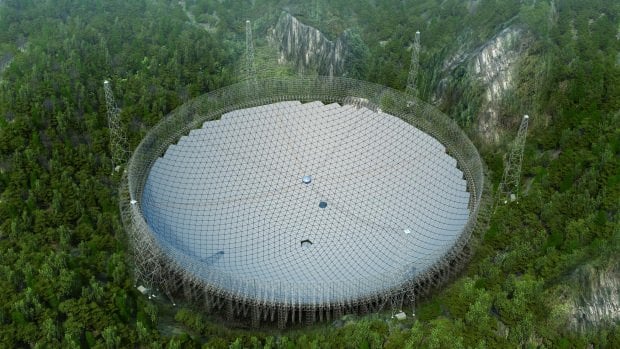China is building the world's largest radio telescope, and will have to move almost 10,000 people from the vicinity to guarantee the telescope's effectiveness. The telescope, called the Five-hundred-meter Aperture Spherical Telescope (FAST), will be completed in September, 2016. At 500 meters in diameter, it will surpass the workhorse
Arecibo
radio observatory in Puerto Rico, which is 305 meters in diameter.
China has routinely moved large amounts of people to make room for developments like the
Three Gorges Dam
. But in this case, the people are being moved so that FAST can have a five kilometre radio-quiet buffer around it.
According to China's news agency Xinhua, an unnamed official said the people are being moved so that the facility can have a "sound electromagnetic wave environment." Common devices and equipment like microwave ovens, garage door openers, and of course, mobile phones, all create radio waves that FAST will sense and which can interfere with the telescope's operation.
The telescope's high level of sensitivity "will help us to search for intelligent life outside of the galaxy," according to Wu Xiangping, director-general of the Chinese Astronomical Society. But aside from searching for radio waves that could be from distant alien civilizations, like
SETI
does, the enormous dish will also to be used to study astronomical objects that emit radio signals, like galaxies, pulsars, quasars, and supernovae. The radio signals from these objects can tell us about their mass, and their distance from us. But the signals are very weak, so radio telescopes have to be huge to be effective.
Radio telescopes are also used to send out radio signals and bounce them off objects like asteroids and the other planets in our Solar System. These signals are detected by the telescope when they return to Earth, and used to create images.
Huge radio telescopes like FAST can only be built in certain places. They require a large, naturally dish-shaped area for construction. (Arecibo is built in a huge karst sinkhole in Puerto Rico.) Though FAST is in a fairly remote location, where there are no major cities or towns, there are still approximately 10,000 people who will have to be moved. Most of the people moved will be compensated to the tune of $2500, with some receiving more than that.
The FAST facility is part of a concerted effort by China to be a dominant player in space study and exploration. The
Chang e 3
mission to the Moon, with its unmanned lander and rover, showed China's growing capabilities in space. China also plans to have its own
space station
, its own space weather station at LaGrange 1, and a
mission to Mars
by 2020, consisting of an orbiter and a rover.
Construction on FAST began in 2011, and will cost 1.2 billion yuan ($260 million) to build.
 Universe Today
Universe Today
